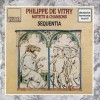| Country: | France |
| Period: | Middle Ages |
Biography
Philippe de Vitry (31 October 1291 – 9 June 1361) was a French composer, music theorist and poet. He was an accomplished, innovative, and influential composer, and may also have been the author of the Ars Nova treatise. He was widely acknowledged as the greatest musician of his day, with Petrarch writing a glowing tribute, calling him: "...the keenest and most ardent seeker of truth, so great a philosopher of our age.
Details of his early life are vague. While some medieval sources claim that he was born in the Champagne region, more recent research indicates that he may have originated in Vitry-en-Artois near Arras.[2] Given that he is often referred to in documents as "Magister," he is thought likely to have studied at the University of Paris. Later he was prominent in the courts of Charles IV, Philippe VI and Jean II, serving as a secretary and advisor; perhaps aided by these Bourbon connections, he also held several canonries, including Clermont, Beauvais and Paris, also serving for a time in the antipapal retinue at Avignon starting with Clement VI. In addition to all this, he was a diplomat and a soldier, known to have served at the siege of Aiguillon in 1346. In 1351 he became Bishop of Meaux, east of Paris. Moving in all the most important political, artistic and ecclesiastical circles, he was acquainted with many lights of the age, including Petrarch and the famous mathematician, philosopher and music theorist Nicole Oresme. He died in Paris on 9 June 1361.
Philippe de Vitry is most famous in music history for the Ars nova notandi (1322), a treatise on music attributed to him which lent its name to the music of the entire era. While his authorship and the very existence of this treatise have recently come into question, a handful of his musical works do survive and show the innovations in musical notation, particularly mensural and rhythmic, with which he was credited within a century of their inception. Such innovations as are exemplified in his stylistically-attributed motets for the Roman de Fauvel were particularly important, and made possible the free and quite complex music of the next hundred years, culminating in the Ars subtilior. In some ways the "modern" system of rhythmic notation began with the Ars Nova, during which music might be said to have "broken free" from the older idea of the rhythmic modes, patterns which were repeated without being individually notated. The notational predecessors of modern time meters also originate in the Ars Nova.
He is reputed to have written chansons and motets, but only some of the motets have survived. Each is strikingly individual, exploiting a unique structural idea. He is also often credited with developing the concept of isorhythm (an isorhythmic line consists of repeating patterns of rhythms and pitches, but the patterns overlap rather than correspond; e.g., a line of thirty consecutive notes might contain five repetitions of a six-note melody or six repetitions of a five-note rhythm).
Five of his three-part motets have survived in the Roman de Fauvel; an additional nine can be found in the Ivrea Codex







